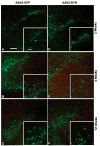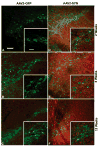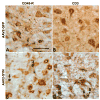Targeted overexpression of human alpha-synuclein triggers microglial activation and an adaptive immune response in a mouse model of Parkinson disease
- PMID: 19018246
- PMCID: PMC2753200
- DOI: 10.1097/NEN.0b013e31818e5e99
Targeted overexpression of human alpha-synuclein triggers microglial activation and an adaptive immune response in a mouse model of Parkinson disease
Abstract
Microglial activation and adaptive immunity have been implicated in the neurodegenerative processes in Parkinson disease. It has been proposed that these responses may be triggered by modified forms of alpha-synuclein (alpha-SYN), particularly nitrated species, which are released as a consequence of dopaminergic neurodegeneration. To examine the relationship between alpha-SYN, microglial activation, and adaptive immunity, we used a mouse model of Parkinson disease in which human alpha-SYN is overexpressed by a recombinant adeno-associated virus vector, serotype 2 (AAV2-SYN); this overexpression leads to slow degeneration of dopaminergic neurons. Microglial activation and components of the adaptive immune response were assessed using immunohistochemistry; quantitative polymerase chain reaction was used to examine cytokine expression. Four weeks after injection, there was a marked increase in CD68-positive microglia and greater infiltration of B and T lymphocytes in the substantia nigra pars compacta of the AAV2-SYN group than in controls. At 12 weeks, CD68 staining declined, but B- and T-cell infiltration persisted. Expression of proinflammatory cytokines was enhanced, whereas markers of alternative activation (i.e. arginase I and interleukins 4 and 13) were not altered. Increased immunoreactivity for mouse immunoglobulin was detected at all time points in the AAV2-SYN animals. These data show that overexpression of alpha-SYN alone, in the absence of overt neurodegeneration, is sufficient to trigger neuroinflammation with both microglial activation and stimulation of adaptive immunity.
Figures











Similar articles
-
Targeting of the class II transactivator attenuates inflammation and neurodegeneration in an alpha-synuclein model of Parkinson's disease.J Neuroinflammation. 2018 Aug 30;15(1):244. doi: 10.1186/s12974-018-1286-2. J Neuroinflammation. 2018. PMID: 30165873 Free PMC article.
-
Fractalkine Signaling Regulates the Inflammatory Response in an α-Synuclein Model of Parkinson Disease.PLoS One. 2015 Oct 15;10(10):e0140566. doi: 10.1371/journal.pone.0140566. eCollection 2015. PLoS One. 2015. PMID: 26469270 Free PMC article.
-
Neuroinflammation and α-synuclein dysfunction potentiate each other, driving chronic progression of neurodegeneration in a mouse model of Parkinson's disease.Environ Health Perspect. 2011 Jun;119(6):807-14. doi: 10.1289/ehp.1003013. Epub 2011 Jan 18. Environ Health Perspect. 2011. PMID: 21245015 Free PMC article.
-
Role of α-synuclein in inducing innate and adaptive immunity in Parkinson disease.J Parkinsons Dis. 2015;5(1):1-19. doi: 10.3233/JPD-140491. J Parkinsons Dis. 2015. PMID: 25588354 Free PMC article. Review.
-
Updates on immunity and inflammation in Parkinson disease pathology.J Neurosci Res. 2018 Mar;96(3):379-390. doi: 10.1002/jnr.24185. Epub 2017 Oct 26. J Neurosci Res. 2018. PMID: 29072332 Review.
Cited by
-
Research progress on the cannabinoid type-2 receptor and Parkinson's disease.Front Aging Neurosci. 2024 Jan 8;15:1298166. doi: 10.3389/fnagi.2023.1298166. eCollection 2023. Front Aging Neurosci. 2024. PMID: 38264546 Free PMC article. Review.
-
Inflammatory cells and cytokines in the olfactory bulb of a rat model of neuroinflammation; insights into neurodegeneration?J Interferon Cytokine Res. 2013 Jul;33(7):376-83. doi: 10.1089/jir.2012.0088. Epub 2013 Apr 19. J Interferon Cytokine Res. 2013. PMID: 23600861 Free PMC article.
-
Microglia acquire distinct activation profiles depending on the degree of alpha-synuclein neuropathology in a rAAV based model of Parkinson's disease.PLoS One. 2010 Jan 20;5(1):e8784. doi: 10.1371/journal.pone.0008784. PLoS One. 2010. PMID: 20098715 Free PMC article.
-
Development of an extended half-life GM-CSF fusion protein for Parkinson's disease.J Control Release. 2022 Aug;348:951-965. doi: 10.1016/j.jconrel.2022.06.024. Epub 2022 Jun 30. J Control Release. 2022. PMID: 35738463 Free PMC article.
-
Extracellular Alpha-Synuclein: Mechanisms for Glial Cell Internalization and Activation.Biomolecules. 2022 Apr 30;12(5):655. doi: 10.3390/biom12050655. Biomolecules. 2022. PMID: 35625583 Free PMC article. Review.
References
-
- McGeer PL, Itagaki S, Boyes BE, McGeer EG. Reactive microglia are positive for HLA-DR in the substantia nigra of Parkinson’s and Alzheimer’s disease brains. Neurology. 1988;38:1285–91. - PubMed
-
- McGeer PL, Schwab C, Parent A, Doudet D. Presence of reactive microglia in monkey substantia nigra years after 1-methyl-4-phenyl-1,2,3,6-tetrahydropyridine administration. Ann Neurol. 2003;54:599–604. - PubMed
-
- Sherer TB, Betarbet R, Kim JH, Greenamyre JT. Selective microglial activation in the rat rotenone model of Parkinson’s disease. Neurosci Lett. 2003;341:87–90. - PubMed
-
- Kurkowska-Jastrzebska I, Wronska A, Kohutnicka M, Czlonkowski A, Czlonkowska A. The inflammatory reaction following 1-methyl-4-phenyl-1,2,3, 6-tetrahydropyridine intoxication in mouse. Exp Neurol. 1999;156:50–61. - PubMed
-
- Reynolds AD, Banerjee R, Liu J, Gendelman HE, Mosley RL. Neuroprotective activities of CD4+CD25+ regulatory T cells in an animal model of Parkinson’s disease. J Leukoc Biol. 2007;82:1083–94. - PubMed
Publication types
MeSH terms
Substances
Grants and funding
LinkOut - more resources
Full Text Sources
Other Literature Sources
Medical
Miscellaneous

